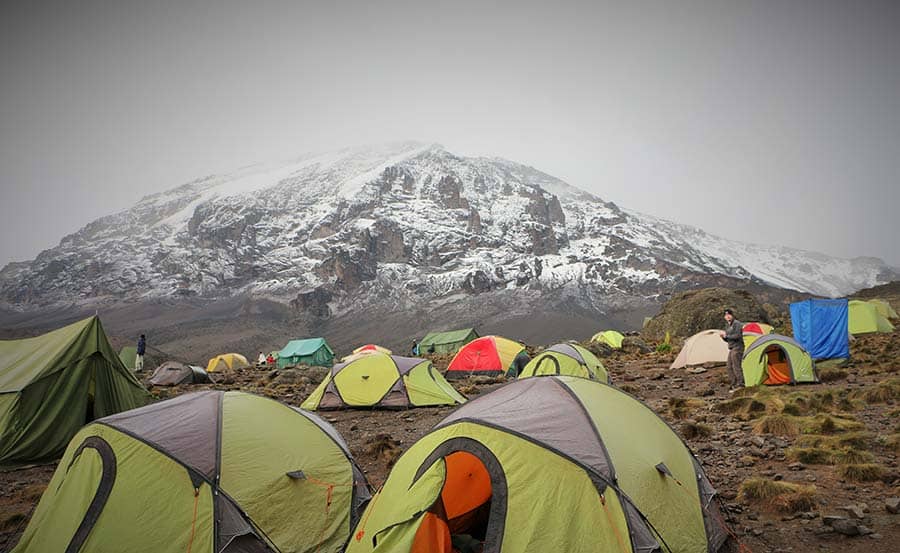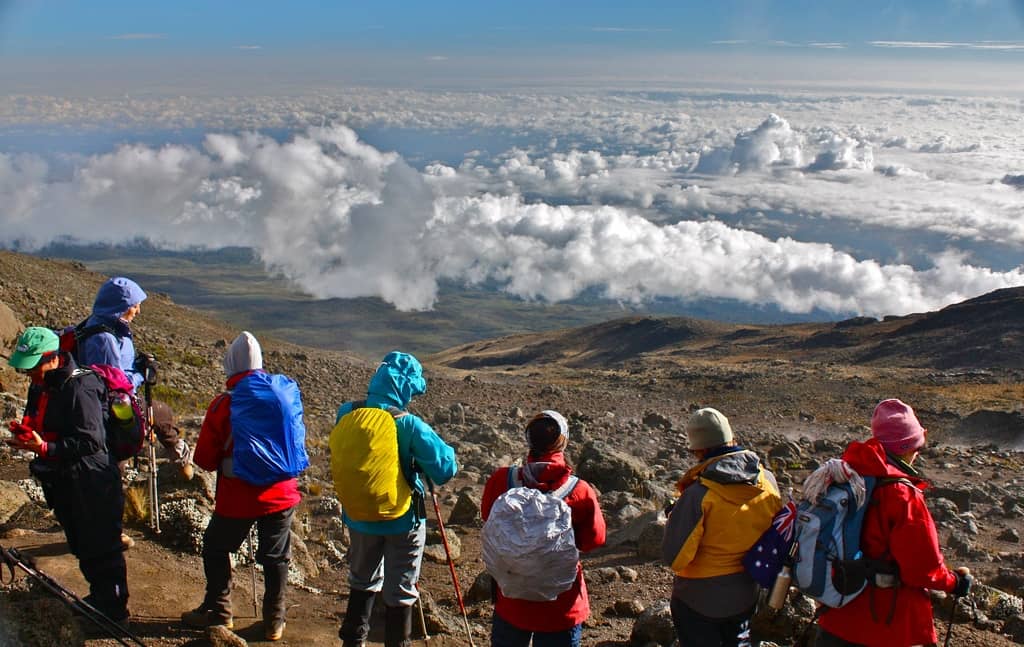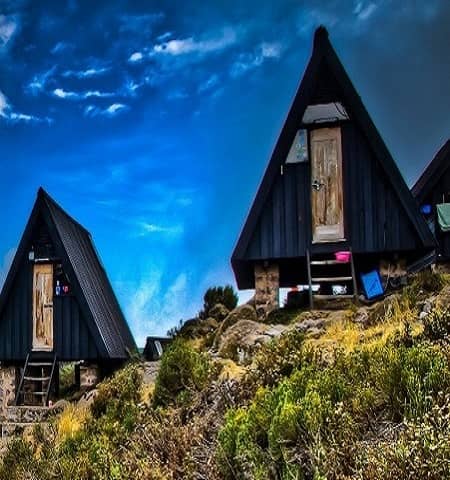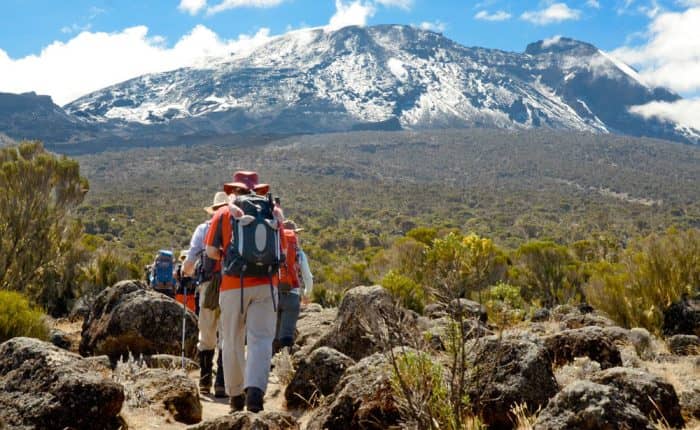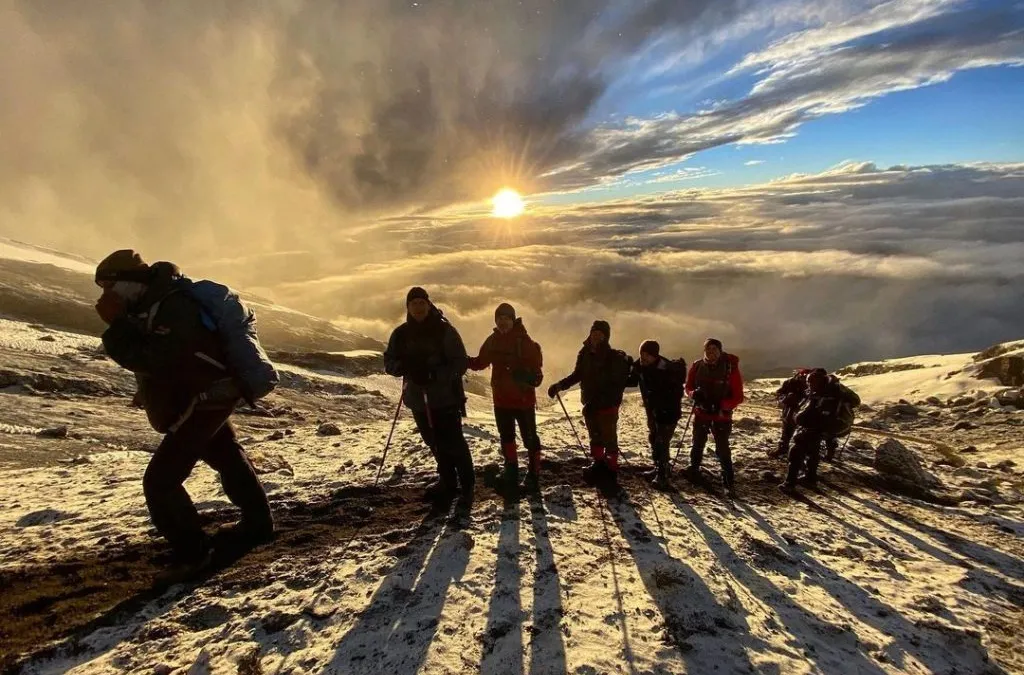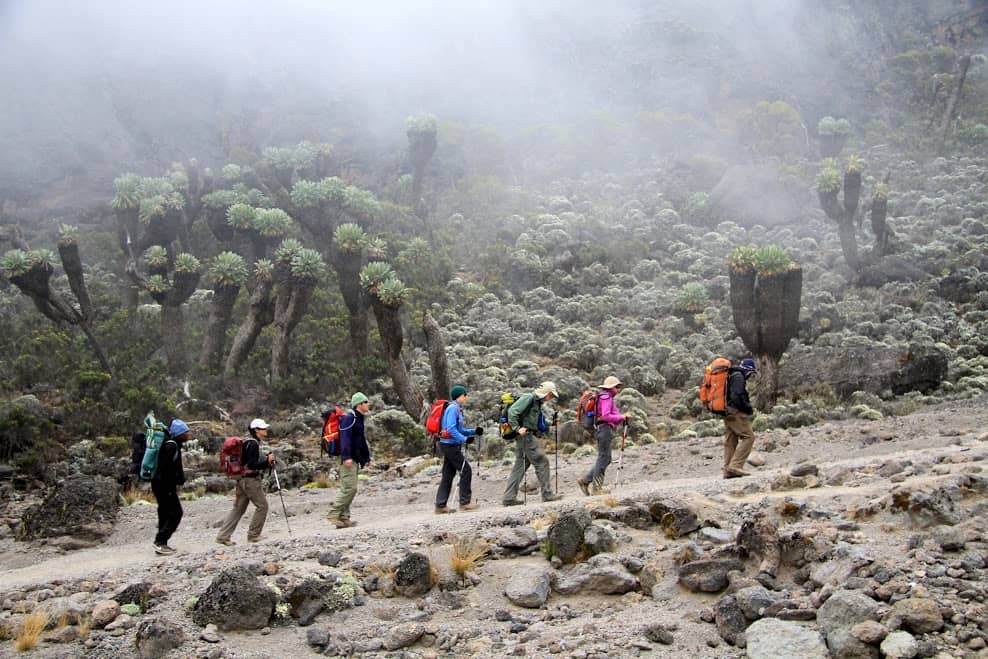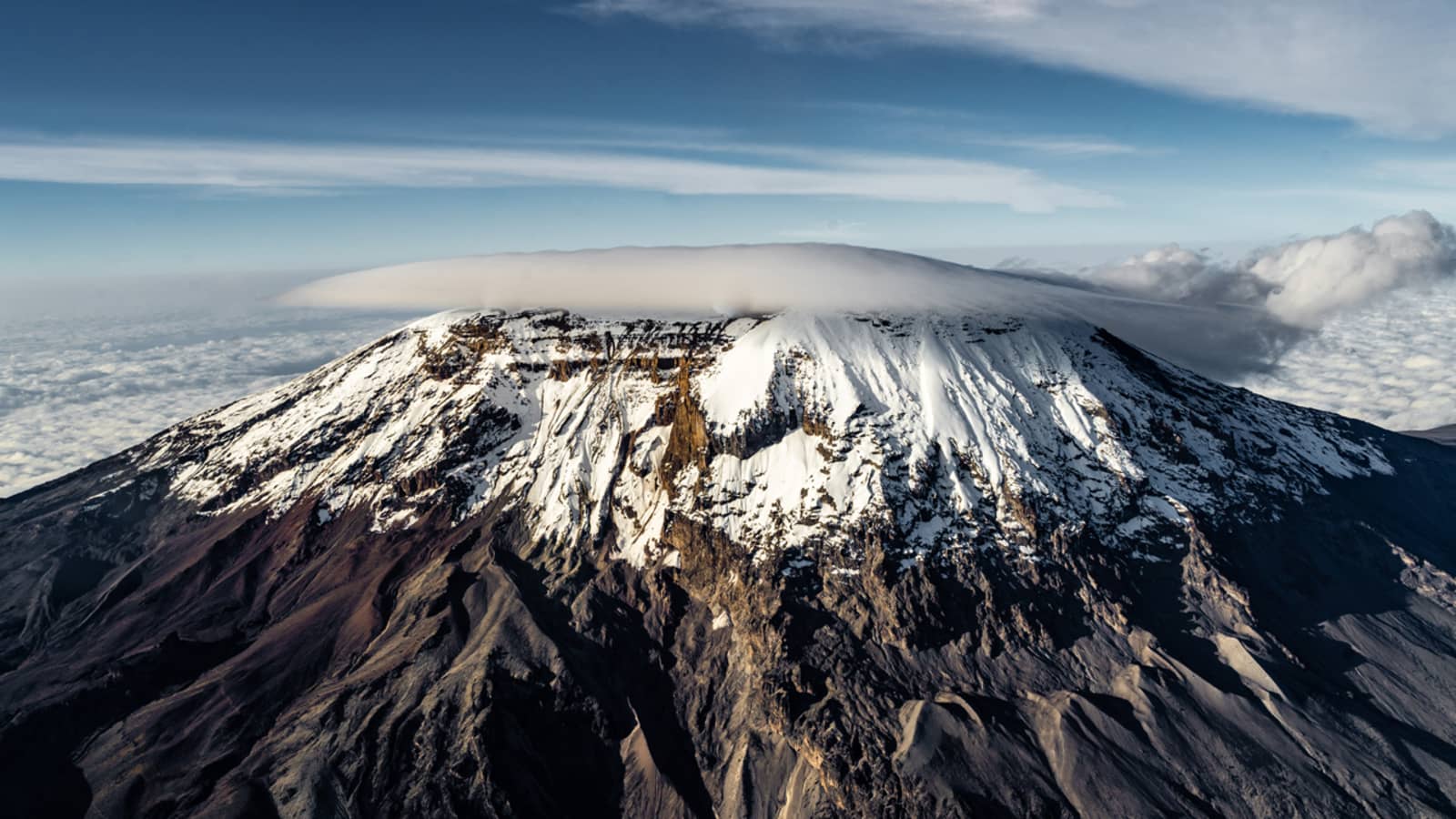KILIMANJARO GUIDE
KILIMANJARO TREKKING ESSENTIAL PACKING LIST
THE- SUMMIT-ASCENT
MOUNT KILIMANJARO HEALTH-ISSUES
MOUNT KILIMANJARO PREPARATION
KILIMANJARO TREKKING ESSENTIAL PACKING LIST
- Solid Hiking Boots– Boots should have high ankle support with a solid Vibram®, or equivalent, sole. Gore Tex®, or other waterproofing, is recommended to have for wet days as well as added insulation. Be sure to break your boots in at least 4 WEEKS prior to departure. Additionally, bring a spare set of laces.
- Sun Glasses – Your sunglasses should have 100% UV protection and should reduce glare as well as visible light. The frames should be lightweight with a wrap-around design for enhanced grip and staying power. Additionally, side shields are recommended to block peripheral light.
- Day Pack – The most important things to look for if you need to purchase one are size (30L is good), hydration pack compatibility, hip and chest straps, internal frame, good padding on shoulder straps, and water bottle holders.
- Water/Windproof Jacket – Your water/windproof jacket is your outer water-repellent layer. Gore Tex, seam-sealed is recommended as well as a hood for added warmth.
- Water/Windproof Pants – Your water/windproof pants will be worn on summit day as well as on rainy afternoons. These pants are essential for warmth and should be Gore Tex lined and have lower leg zips.
- Water/Windproof Mittens or Gloves – These are used for extreme temperatures and primarily worn on summit day. Be sure your gloves or mittens have a wrist cord as well as a reinforced palm to maintain grip during wet conditions. A removable liner is essential for drying, washing, and replacing.
- 2 large duffel bags – One we will leave at the hotel in Arusha to store non-essential gear when on the mountain (such as clean clothes for changing when off the mountain and for onward travel) and the other for carriage by the porters when on the mountain.
Look for items that will add less volume to your overall pack. We will be using porters to carry our equipment however they are limited in the amount each can carry. Heavy synthetic materials will be very limiting and could cause issues when packing up for the hike.
2 pairs synthetic warm weather trekking socks – These socks are for trekking in the warmest part of the day since they are made of a Coolmax® fabric. What is Coolmax®? – CoolMax® wicks moisture dries quickly and breathes well, keeping your feet dry and preventing blisters.
4 pairs heavier synthetic or wool blend socks – Your wool socks are ideal for around camp when the temperature drops as well as on cold mornings. Merino wool is very comfortable and dries quickly with fewer odors than synthetic blends.
2 pairs long underwear top – This will be your base layer for colder mornings, evenings, and days where the temperature drops considerably. The material is lightweight, tight-fitting, moisture-wicking, and comfortable.
2 pairs long underwear bottom – This will be your bottom base layer for colder mornings, evenings, and days when the temperature drops considerably. The material is lightweight, tight-fitting, moisture wicking, and comfortable.
Warm pants – These pants are ideal for evenings around the camp and cold days on the trail. Typically made of lightweight fleece and Wind Pro material, these pants should offer the added warmth in case of cold nights or high winds on the summit.
Fleece Top – This Polartec® 200 weight top will provide added warmth during the evenings as well as on cold morning starts. Please look for fleece material and stay away from cotton sweatshirts. Ideally, this item is worn over the thermal base layer and underneath your water/windproof jacket.
2 pairs Shorts/Pants for Hiking- These convertible shorts/pants will be what we hike in every day. They should be of a lightweight, quick-drying nylon material. Some come with UPF protection and mosquito protection.
2 pairs long or short sleeve shirts for the trail – Your trekking shirt is what we should wear early in the climb in warmer climates. The shirt is moisture wicking, lightweight, and designed for multi-day hikes.
Mid-Layer Top – This shirt is a long sleeve version of the one provided above. The long sleeve trail shirt offers added warmth, more protection from the sun, and an additional layer for evenings and early morning starts.
Warm Hat – This fleece or wool hat is ideal for evenings and will be valuable in the event of cold weather and temperatures on the summit. The hat should be tight fitting with minimal loose ends.
Lightweight Gloves – Fleece gloves are essential. Look for gloves that are Polartec® 200 weight with a leather reinforced palm. For more protection windproofing is available and will add an extra layer of warmth.
Balaclava – The balaclava provides added warmth on summit day and colder evening. The balaclava should be of synthetic or wool material, lightweight, and close fitting.
Sun hat – Your sun hat should be worn at the lower camps and should provide ample coverage for the face. A full brimmed hat is good for added shade and increased sun protection. Additionally, a neck scarf should also be considered to protect the back of the neck”.
Waterproof breathable Gaiters – Your gaiters should be lightweight and durable. Look for Gore Tex lined with the ability to fit over your boots. Velcro or adjustable sides for easy access is recommended.
Down Jacket – 800 fill down jacket will add much need warmth for cold evenings as well as the added layers for summit day. Down is recommended for its compressibility and is comfortable around camp in the early nights on the climb. Patagonia, Mountain Hardware, Marmot, and North Face are brands the guides wear.
- Head Lamp- Petzl® and Black Diamond® make several models of small and efficient headlamps. Look for ones that have multiple lighting levels, LED bulbs and uses AAA batteries.
* Please bring at least 3 sets of spare batteries to ensure ample lighting on your summit attempt.
- Camp shoes (Teva, Crocs, Sandals) – These are great for around camp after a long day on the trail. These can also be used for creek crossings that may be higher than the boot. Flip flops work well in warmer climates but are not as effective during cold nights.
- Hydrator – Hydrators are ideal when hiking for several hours because they enable you to drink slowly and frequently. 2-3 liters is a good size and should fit easily into your pack. All Camelbaks® come with a bite valve, or on/off switch, as well as a large access port for filling. You must bring a NEOPRENE SLEEVE for the hose to prevent freezing.
- Bug Spray – DEET based products work well and we find that the spray on versions last longer and are less messy. 4-6 ounce repellents that are perspiration and splash resistant are great.
- Sun Screen – 30 SPF or higher is recommended as well as waterproof and sweat proof. 8 ounces will be plenty and we typically carry one with 45+ SPF for our faces and a 30 SPF for other exposed areas. Banana Boat, REI, Kinesis and All Terrain are good options.
- 2 wide mount water bottle – A 1-liter water bottle is essential for hydrating at lunch, around the camp, and refilling throughout the day. Stay away from glass and heavy metals and look for lexan® for durability.
* For males, a third water bottle should be considered for use as a potty at night and must be labeled accordingly.
- Pillow– A Thermarest® pillow that compresses down or folds into itself is ideal. A good benchmark for size and weight are 18 X 14 inches and 9 ounces total.
- Dry Bag – A 20 liter + dry bag is great for ensuring your personal items are safe in case of rain. Cameras, wallets, money, and any other valuables can be kept dry at all times.
- Pack Cover – The pack cover is an additional item we recommend everyone carry in case we encounter heavy rains. The pack cover should have a drawstring cord and elastic edges to fit firmly over your bag. A 40-liter cover will work well on any day pack.
- Trekking Poles – Collapsible poles are great for steep downhill terrain and assistance up the hill. If you have knee problems they reduce the impact on your joints by 20-30%. A nice soft foam grip will help prevent blisters and the poles with an aluminum shaft are durable and lightweight.
- Camp Towel – the camp towel should be of a polyester nylon blend that dries quickly and compacts tightly in your pack. The large (50 X 27 inches) is a good size and can be used to wash up at the end of the day. Stay away from the house or beach towels.
- Camera
- Paperback book
- Journal with pen or pencil
- Person First Aid Kiband-aid side, moleskin or second skin, Ibuprofen, Aspirin)
- Hand sanitizer
- Sani-wipes
- Hand & feet warmers (2X) – Gel/ air activated are best
- Bandanna
- Cell phone (with solar charger e.g. solar monkey charger) since you tri and quad-band phones work on Kilimanjaro
- Flavored chocolate/energy bars for snacks
- A supply or rehydrate sachets
- 2 extra garbage bags for waterproofing and separating dirty laundry
- Earplugs
- iPod or MP3 player
- Pocket knife
- Water-flavoring to mask the iodine taste in the purified water.
THE- SUMMIT-ASCENT
Introduction
Your summit attempt is really the big day. You will finally know whether you will walk on the roof of Africa, or at least be able to say that you tried. Of course, you want to make it to the summit.
Your summit attempt is really the big day. You will finally know whether you will walk on the roof of Africa, or at least be able to say that you tried. Of course, you want to make it to the summit. Here are a few things that you can do to give you the best chances of making the summit on your first attempt.
Even though you will be starting very early you must make the most of the time you have in base camp and get as much sleep as you can. If you’ve been eating and drinking properly, you’ll probably be up a few times during the night as it is.
It is nearly impossible to eat or drink too much at this stage. Summit day will be a 14 to 15-hour trek, and it will not be easy going. You can expect to burn more than 4000 calories on summit day alone, so eat well. You’ll be hiking for some 15 hours, virtually non-stop. Bring snacks and a lot of them! Remember to put some of them in your pockets, preferably in warm places, that you have easy access to so that you can nibble while you walk without having to stop every time to get something out of your rucksack. Bring what you like best, but we have found that some of the best options are candy bars/chocolate, cookies/biscuits, crisps, energy bars, hard candy/boiled sweets, nuts/dried fruit, and trail mix. Nuts are great at altitude as they don’t freeze, whereas energy and candy bars, particularly chocolate ones, tend to freeze about 5000 meters, and drink at least twice as much water as you think you should even when you are not thirsty or hungry.
The risks of dehydration are very high at altitude and they also mirror the symptoms of AMS, so our mantra is to drink a minimum of 3 liters every single day of the climb to keep you fully hydrated. These fluids can be made up of hot drinks with your meals plus a minimum of 2 liters fluid whilst you are actually trekking. Sounds easy doesn’t it, but you need to be self-disciplined and self-aware to actually do it when you are tired and think you are not thirsty.
Also, for summit night you will need to carry water in a wide mouthed Nalgene bottle as above 5000 meters everything freezes! You may be surprised to learn that water freezes from the top down, so firstly insulate your Nalgene bottle by stuffing it inside a spare pair of socks and then pack it upside down in your rucksack. If you are using a platypus then make sure that the pipe is insulated or keep it tucked inside your clothes and jacket and just pull the mouthpiece out when you need to take a drink, then blow the water back down the tube before you put the mouthpiece back. Platypus users will also need to carry a liter of fluid in a wide-mouthed Nalgene bottle as a precautionary measure.
We cannot stress enough. The attempt on the summit is exhausting, and you have to fuel the climb if you expect to make it. Eat like a 5-year-old at Christmas and enjoy all those extra calories!
Making sure you are neither too hot nor too cold will conserve your energy for when you really need it. You should be slightly cooler than is comfortable when you first set off. ‘Be bold, start cold’ as we say. We advise you to remove your over jacket or down jacket when you set off, then immediately put it back on when you make a ‘maintenance stop’. This will keep you more comfortable, and make sure you aren’t expending energy sweating that you could be used to climb to the summit!
During the attempt on the summit, we will have quite a few short ‘maintenance stops’. These do not rest stops, and you shouldn’t rest. Plan what you will need to do at your next stop while you hike. At the very least, you will need to put on something warm as soon as you stop, have something to eat and drink, and make sure your kit is in good order. If you have been drinking as much as you should be, you will probably need the loo, as well.
Our guides will set a pace that takes the needs of your entire group into account, and you should try to maintain it if at all possible. Try to go too fast and you will put yourself at extra risk of altitude sickness. Going too slow will mean that you have little time for anything but hiking and sleeping. Just keep plodding along with your guide, and you will get there at just the right time.
MOUNT KILIMANJARO HEALTH-ISSUES
Introduction
Your summit attempt is really the big day. You will finally know whether you will walk on the roof of Africa, or at least be able to say that you tried. Of course, you want to make it to the summit.
Please note Each client that books with ‘Outstanding Tanzania Safari‘receives a comprehensive 2-page health guide that addresses all the health issues related to climbing Kilimanjaro.
Acute Mountain Sickness is also referred to as “Altitude Sickness”, and as the name indicates the illness is commonly encountered at exceptionally high altitudes, such as the summit area of Mount Kilimanjaro. AMS, once apparent, can be most effectively treated by immediately taking the affected person to a lower altitude. Often a drop as little as 500m will be sufficient. The symptoms of AMS include in the order normally experienced; headaches, nausea, anorexia, exhaustion, lassitude, rapid pulse, insomnia, swelling of the hands and feet and reduced urine output. Climbers can take precautions to at least minimize the severity of the illness, by maintaining a slow steady pace from day one, including an extra day of acclimatization at a high altitude and by drinking at least 3-4 liters of water every day. Preventative medicine is also available and you should consult your physician for specialist advice. Fluid build-up may cause a condition known as edema (or edema), which can affect the lungs (pulmonary), preventing effective oxygen exchange, or affect the brain (cerebral) which will result in the swelling of the brain tissue. The latter can be lethal if not treated immediately or if symptoms are ignored. Probably 70% of all people climbing Kilimanjaro will suffer to some extent from AMS. You should familiarise yourself with this condition and take preventative care.
Hypothermia or exposure is the lowering of the body’s core temperature. Once again prevention is the best cause of action. The correct equipment and clothing are critical in the prevention of Hypothermia. Do not allow your clothing to get wet from either rain or perspiration.
The treatment of hypothermia is relatively simple. Get the victim into a sheltered area as quickly as possible, remove all wet clothing and place the victim inside two or three sleeping bags, preferably with another person to help heat the victim.
About 55% of the earth’s protective atmosphere is below an altitude of 5000m. Far less ultraviolet light is being filtered out, making the sun’s rays much more powerful, which could result in severe sun burning of the skin. It is strongly recommended to use a 20+ sun protection cream at lower altitudes, and a total block cream above an altitude of 3000m. It is also important to wear dark sunglasses preferably with side panels above 4000m in the daytime and essential when walking through snow or ice. Snow blindness can be very painful and will require your eyes to be bandaged for at least 24 hours.
Any climber who suffers from any cardiac or pulmonary problems should be cautious and should not attempt to climb the mountain unless they have consulted their physician. It is strongly recommended that a physical fitness program is followed to prepare yourself physically for the mountain.
Poor fitting, new or little used boots will result in blistering feet. Even if boots are only slightly too small, your toes will get bruised, particularly on you descend. It is it therefore also important to keep your toenails short for the climb. Developing blister should be treated immediately as soon as the “hot spot” is felt. Remove the boot and cover the area with a zinc oxide tape or something similar.
MOUNT KILIMANJARO PREPARATION
Introduction
KILIMANJARO SUMMIT PREPARATION Achieving a reasonable degree of physical fitness should be a goal in your preparation.
Achieving a reasonable degree of physical fitness should be a goal in your preparation. Being in good shape will increase your chances of having a safe climb, successful summit, and enjoyable experience.
Achieving a reasonable degree of physical fitness should be a goal in your preparation.
Being in good shape will increase your chances of having a safe climb, successful summit, and enjoyable experience.
Climbing Kilimanjaro does not take any technical mountaineering skills. It is a trek at high altitude, and nearly anyone in decent physical condition can climb Mount Kilimanjaro. However, one should not underestimate the effort required over six to nine days to reach the peak.
The main reason that climbers fail to reach the summit is due to the inability to acclimatize to the high altitude quickly enough. Short of going to high altitude, there is little that one can do to pre-acclimatize before the climb. Being physically fit does not guarantee that climbers can overcome altitude issues, but it does reduce the strenuousness of the climb on the body, which in turn, makes acclimatization more likely.
Ideally, your training should simulate actual conditions encountered on Kilimanjaro.
Performing day hikes on local trails are the recommended form of training. The trails should include uphill and downhill sections, and you should wear the clothing, boots, and pack that you intend to climb in. Try to hike for several hours. Your hikes on the mountain will on average be between four to six hours but can be as little as two (easy days) and as high as 14 hours (summit day). If it is impractical for you to train outdoors, you may exercise at the local gym. The staple of your training should be walking on a Stairmaster, supplemented with weight-training for your legs.
A minimum of three days a week, perhaps shorter sessions during the weekdays and longer sessions on the weekends, for three months, is suggested. With proper training, you will develop the leg strength, endurance, and confidence necessary for Kilimanjaro.
Our trips begin in Arusha, Tanzania, Clients should fly into Kilimanjaro International Airport (airport code: JRO) and we make the way to the designated hotel in Arusha.
Watching the sunrise on top of Mount Kilimanjaro is a highlight – literally. The adventure of climbing Kilimanjaro, the Roof of Africa, is an experience you will carry for the rest of your life. It is the tallest free-standing mountain but the highly accessible summit attracts amateur and professional climbers from all over the world. With preparation, focus, and motivation you can beat any mental or physical barrier to reach Uhuru Peak at 5895m/19341ft. It is the ultimate adventure in Africa, part of the world’s 7 summits, and extremely rewarding when you reach the top and feel the sense of accomplishment at Uhuru Peak.
Safety comes first when climbing any mountain. Therefore, your experience, personal physiology, and health condition must be considered in the choice of route and number of days. In general, spending more days for acclimatizing lets you enjoy more and increase the probability of success. Our gear list is also provided in the program we create for you together with additional useful information, to help you prepare a successful expedition with safety and quality of experience.
Our Kilimanjaro Head and Assistant guides are licensed and professionally trained to take you safely to Uhuru peak, and back. Our Head guides have experience of 50-100+ successful summits and work with a handpicked crew of experienced Assistant guides, Cooks, and Porters. Their strong, genuine and friendly characters combined with their passion for Kilimanjaro contribute to the quality of experience, link to Kilimanjaro culture and provide that extra motivation, when needed during the expedition, to reach the summit and come back safely.
Kilimanjaro porters are the heart and soul of the mountain. There are few experiences as humbling as being passed by porters on a climb. They carry food, water, and equipment to ensure a comfortable climb and increased summit success rate. They are certainly among the hardest working men in Tanzania and we make sure they are rewarded properly for their efforts. Outstanding Tanzania Safari porters receives $18/person/day, which is the highest salary levels and un-preceded in the history of Kilimanjaro expeditions. We are proud of this fact and know that this is a fair amount, agreed upon by our staff, for the hard work done!
Marangu, Machame, Lemosho, Rongai, Shira, and Umbwe are the routes we choose from depending on your preferences, time and experience. We highly recommend Machame route for 7 days or Lemosho route for 8-9 days. Both routes allow great acclimatizing opportunities, highest chances of summit success and varied scenery of the mountain each day boosting motivation.
Why Outstanding Tanzania Safaris
Safari Tour Specialists35+
We have many experts that have been in hospitality industry for long and who can deliver full satisfaction to trevellers
Years of experience12
We have been here for long and we understand well what our clients needs. An adventurous journey with us.
Safe traveling98%
Our guides a fully vaccinated and take full precaution on all rules that are stipulated under the safety rules.

